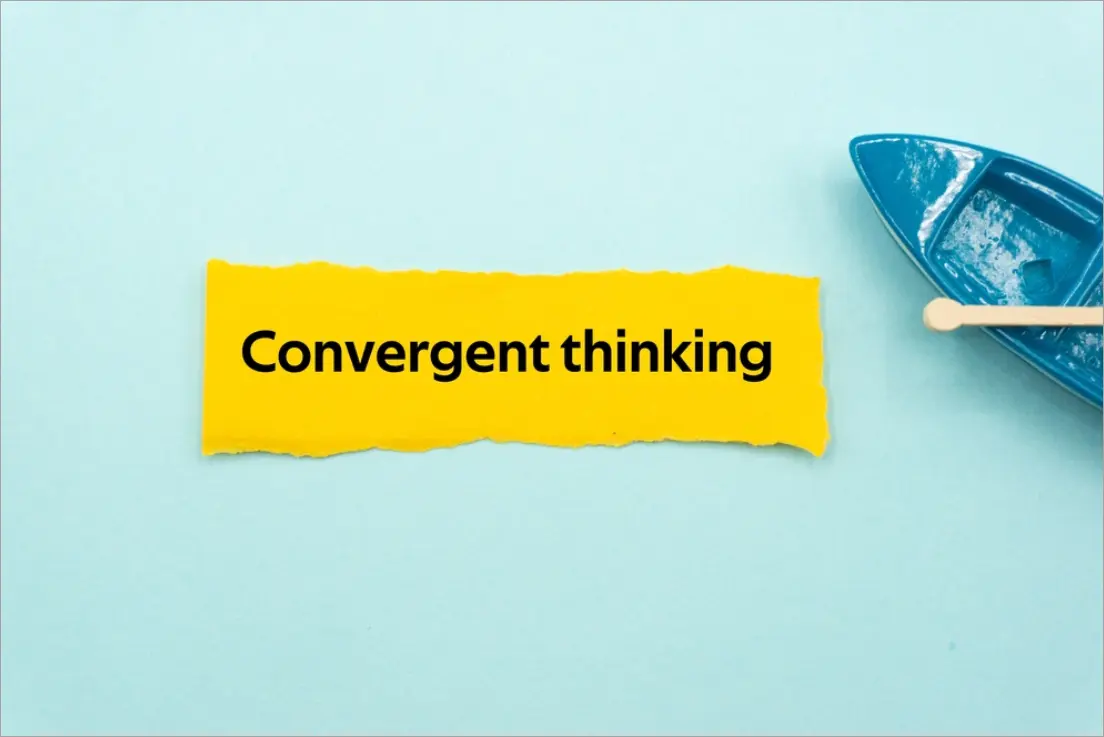Every day, an organization meets challenges. As a result, a company needs to use a variety of approaches to tackle a problem. Diverse thinking helps in finding innovative solutions to challenges, as well as encouraging collaboration and brainstorming, resulting in increased team engagement and loyalty. Project managers employ this creative thinking technique to find effective solutions to problems. It embraces two types of thinking: Convergent thinking and Divergent thinking. Convergent thinking is finding a single effective solution to the problem while divergent thinking is finding multiple creative solutions for problems.
Jump ahead to
What is Convergent thinking?

Convergent thinking is the method of determining the most efficient solution to a problem. It is the process of swiftly and efficiently selecting the best answer from a finite collection of ideas. Then project managers engage in sorting, assessing, and analyzing it in order to solve a discrete problem. Some of those ideas will be discarded because they are too costly, time-consuming, resource-intensive, or just too unconventional. The important aspects of convergent thinking are accuracy, speed, and logic. Project managers mostly use this type of thinking in situations where a problem has to be solved rapidly by aligning teams, building procedures, and planning projects.
The benefits of Convergent thinking are:
- Quick and accurate solutions to any problem
- No possibility of misunderstanding
- Encourages linear processes in an organization
What is Divergent Thinking?
Divergent thinking is a method of generating multiple creative ideas as solutions to the problem. It produces many unique and original ideas since it is spontaneous, free-flowing, and nonlinear. This kind of thinking generates numerous potential solutions and ideas in a short amount of time. Divergent thinking may not be able to find solutions faster, but the solutions it does create will be effective for a long time. Project managers use this kind of thinking to impress and satisfy their customers as they provide creative ideas for problems. Furthermore, project managers will employ divergent thinking during the brainstorming and ideation phase of the project management process to get various knowledgeable ideas and to encourage new solutions from the team members.
The benefits of Divergent thinking:
- Find unique creative solutions to problems
- Assess solutions from multiple perspectives
- Boost teamwork
- Enhances collaboration and team morale
What is the difference between Convergent Thinking and Divergent Thinking?
Solution
Project managers will only obtain one potential answer to the problem while using convergent thinking. Divergent thinking, on the other hand, yields a variety of innovative solutions to the problem. When a project manager wants a speedy response, he or she will apply Convergent thinking. On the other hand, Divergent thinking is employed to come up with excellent solutions that will persist for a long time.
Features
Convergent thinking improves the pace of performance. It helps to break down problems into smaller pieces so that precise, logical, and effective solutions may be found much faster.
Divergent thinking promotes flexibility and outside-the-box thinking and looks at problems from several perspectives, resulting in more innovative thoughts than convergent thinking.
Time
Convergent thinking takes less time while finding solutions to the problems as it generates a single solution to the problem. On the contrary, divergent thinking is a time-consuming process since it takes a longer time to produce many innovative solutions for a single problem.
What is the need for combining both Convergent thinking and Divergent thinking?
Convergent thinking and Divergent thinking can be combined by project managers to come up with an effective solution to a problem. When confronted with an issue, a project manager can use both strategies, depending on the circumstances. Divergent thinking is beneficial for creativity, whereas convergent thinking is beneficial for efficiency. Furthermore, using divergent thinking often might result in prolonged brainstorming with no results whereas, frequent use of convergent thinking can also result in a lack of fresh ideas.
Conclusion
The main difference between convergent thinking and divergent thinking is that, the former is focused on coming up with a single effective solution to the problem. Contrarily the latter is used to come up with several creative solutions to solve the same issue. Also, it is vital to consider which kind of thinking may best suit the present circumstances and the environment in which a problem has arised. Moreover, both the strategies can be integrated to provide an effective solution to the problems that can potentially impact the organization.
Such strategic thinking can be applied by project managers of the organization as they are responsible for solving every kind of project problems. To dive deeper into such strategic methods of solving problems/conflicts, professionals can take up formal training sessions to earn credentials in the field. A certification such as CAPM offered by PMI, assists professionals in grasping such deeper insights on solving project related problems. Enrolling in CAPM Training Course can assist individuals in gaining hands-on experience of the problem-solving cycle employed in organizations.
Summary:
Two ways people approach problem-solving in projects are convergent and divergent thinking. Convergent thinking helps you focus on one clear, logical answer when decisions need direction. Divergent thinking encourages exploring creative ideas and letting possibilities expand freely. Using both together helps teams generate fresh ideas and shape them into practical solutions. Convergent thinking adds clarity, while divergent thinking keeps imagination active. Switching between the two makes project challenges easier to handle and decisions more balanced. Anyone interested in strengthening these skills can explore project management training to enhance their problem-solving approach.
FAQs About Convergent vs Divergent Thinking:
1. What does convergent thinking focus on in problem-solving?
Convergent thinking centers on choosing the most accurate and practical solution. This approach uses logic and evaluation to bring clarity.
2. What does divergent thinking encourage during idea generation?
Divergent thinking opens the mind to explore many different possibilities. Teams can discover options they may not consider normally.
3. How do these thinking styles influence creativity in projects?
Divergent thinking sparks creativity by widening perspectives. Convergent thinking shapes those ideas into focused actions.
4. How does switching between the two improve team performance?
It helps teams explore freely and then refine ideas with purpose. This balance reduces confusion and improves collaboration.
5. How does convergent thinking reduce project risks?
Convergent thinking filters out weak ideas using structured evaluation. Only practical options move forward, lowering uncertainty.
6. How does divergent thinking support early-stage planning?
Divergent thinking encourages teams to look beyond obvious choices. This leads to richer discussions and stronger starting points.
7. Why is divergent thinking helpful for overcoming creative blocks?
It breaks routine patterns and introduces new angles. This unlocks ideas that structured thinking may miss.
8. How does convergent thinking help with time-sensitive decisions?
It narrows down choices quickly using logic and evidence. Teams reach decisions faster without losing accuracy.
9. What role do these thinking styles play in innovation?
Divergent thinking fuels experimentation and fresh concepts. Convergent thinking converts them into workable innovations.
10. How can leaders encourage both thinking styles in teams?
Leaders can allow free idea flow before moving to evaluation. This creates a healthy balance between creativity and structure.
11. What habits strengthen divergent thinking?
Curiosity, open questioning, and collaborative brainstorming. These help widen perspectives naturally.
12. What habits strengthen convergent thinking?
Organizing information, comparing options, and using frameworks. These make decisions clearer and more structured.
13. Why should professionals learn both thinking methods?
Each style brings benefits that the other cannot provide alone. Mastering both improves adaptability in complex situations.
14. Can training improve your ability to use both effectively?
Yes, practice and guided learning make switching between styles easier. This leads to sharper ideas and stronger outcomes in real projects.



